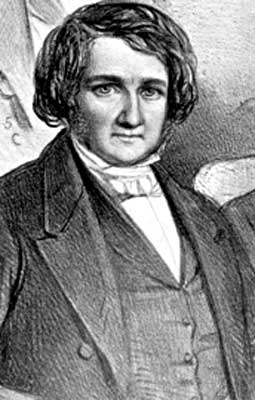Professor James Young Simpson
(1811 – 1870)


"All pain is per se and especially in excess, destructive
and ultimately fatal in its nature and effects."Mid-19th century Britain was still a deeply religious society. Biblical literalism was common in patients and sometimes their doctors. A woman in labour who sought pain-relief no longer risked being burned alive as a witch on royal command; but any innovation that challenged the natural and God-given order of the world was bound to be controversial. Early in the 21st century, Christian fundamentalism has declined, but the under-treatment of all forms of pain is still rife. Obstacles to adequate pain-relief abound in religious and secular societies alike. Pharmacological and genetic technologies to alleviate or abolish emotional pain are likely to be contested for many decades to come.
Dr James Simpson was born the seventh son and eighth child of an impecunious baker. After a rapid ascent up the medical academic ladder, he was appointed professor of medicine and midwifery at Edinburgh in 1839 at the remarkable age of twenty-eight. Simpson combined intellectual brilliance with compassion. Distraught after witnessing the practice of surgery without anaesthesia, Simpson wrote of "that great principle of emotion which both impels us to feel sympathy at the sight of suffering in any fellow creature, and at the same time imparts to us delight and gratification in the exercise of any power by which we can mitigate and alleviate that suffering."
At first this seemed a forlorn hope. Simpson tried mesmerism; it didn't work. Then came news of the revolutionary breakthrough across the Atlantic. Anaesthesia was initially used in dentistry and surgery. Simpson pioneered chloroform anaesthesia in obstetrics. Earlier in January 1847 he had used diethyl ether in Edinburgh to relieve labour pains. In Answer to the Religious Arguments advanced Against the Employment of Anaesthetic Agents in Midwifery and Surgery (1847), Simpson sought to demolish all conceivable religious objections to painless surgery and childbirth.
It is tempting to dismiss some of Simpson's opponents as straw men. Certainly, Simpson tended to exaggerate the strength of religious hostility to anaesthesia and underplay more practical medical worries. Yet it is also a tribute to Simpson's success that within fifteen years or so the ideological battle had essentially been won - though deep controversies remained over the least dangerous and most effective anaesthetic agent to use. Simpson championed chloroform. For a time it became more fashionable. Ether is smelly, inconvenient and flammable, but it proved safer.
Obstetric anaesthesia remained controversial for far longer - indeed dissent persists to this day. But most doctors were more worried about potential risks to mother and baby than the weakness of any theological rationale of its use. Physicians like Thomas Brown, who claimed that unnatural painlessness in delivery was an invention of the Devil, formed a dwindling minority.
For the most part, Simpson's medical opponents recognised that alleviating the agony of childbirth was desirable, in principle at least. Thus Dr Tyler Smith, writing in the Lancet (March 27, 1847: 321-323), opposed obstetric anaesthesia on the grounds that labour pain induced the mother to cry, and her cries, "by opening the glottis, takes away all expiratory pressure, and leaves the uterus acting alone". But Dr Tyler Smith also acknowledged: "No human suffering, perhaps, exceeds in intensity the piercing agonies of child-bearing, and no benevolent mind but would consider it an inestimable blessing to be able to relieve women with safety from so great a trial. I do not underrate the importance of pain or of its alleviation. There are women who after one labour remain their life long depressed and in dread of the repetition of their sufferings." Once it was demonstrated that pain itself played no vital functional role in the birthing process, medically conservative or merely cautious physicians set their reservations about obstetric anaesthesia aside.
Critically to the success of the wider revolution, the disparate religious and secular opponents of anaesthesia weren't organised. Furthermore, there was no legislative framework in place to regulate and restrict the introduction or extensive use of the new agents. Independent gentlemen researchers, doctors and their patients could simply try out any potential anaesthetic or analgesic they chose - and many of them did so.
Professor Simpson, the apostle of chloroform anaesthesia, was a passionate opponent of pain and its apologists as long as he lived. His medical contributions extended beyond obstetric anaesthesia. Simpson pioneered the uterine sound, long forceps, wire sutures, and improved statistical analysis of operative outcomes. When he died in 1870, over 30,000 mourners lined the streets of Edinburgh for his funeral - a send-off few doctors or surgeons could hope for today. The plaque dedicated to James Simpson in Westminster Abbey reads:
The world owes the blessings derived
From the use of chloroform for
The relief of suffering
Laus Deo"